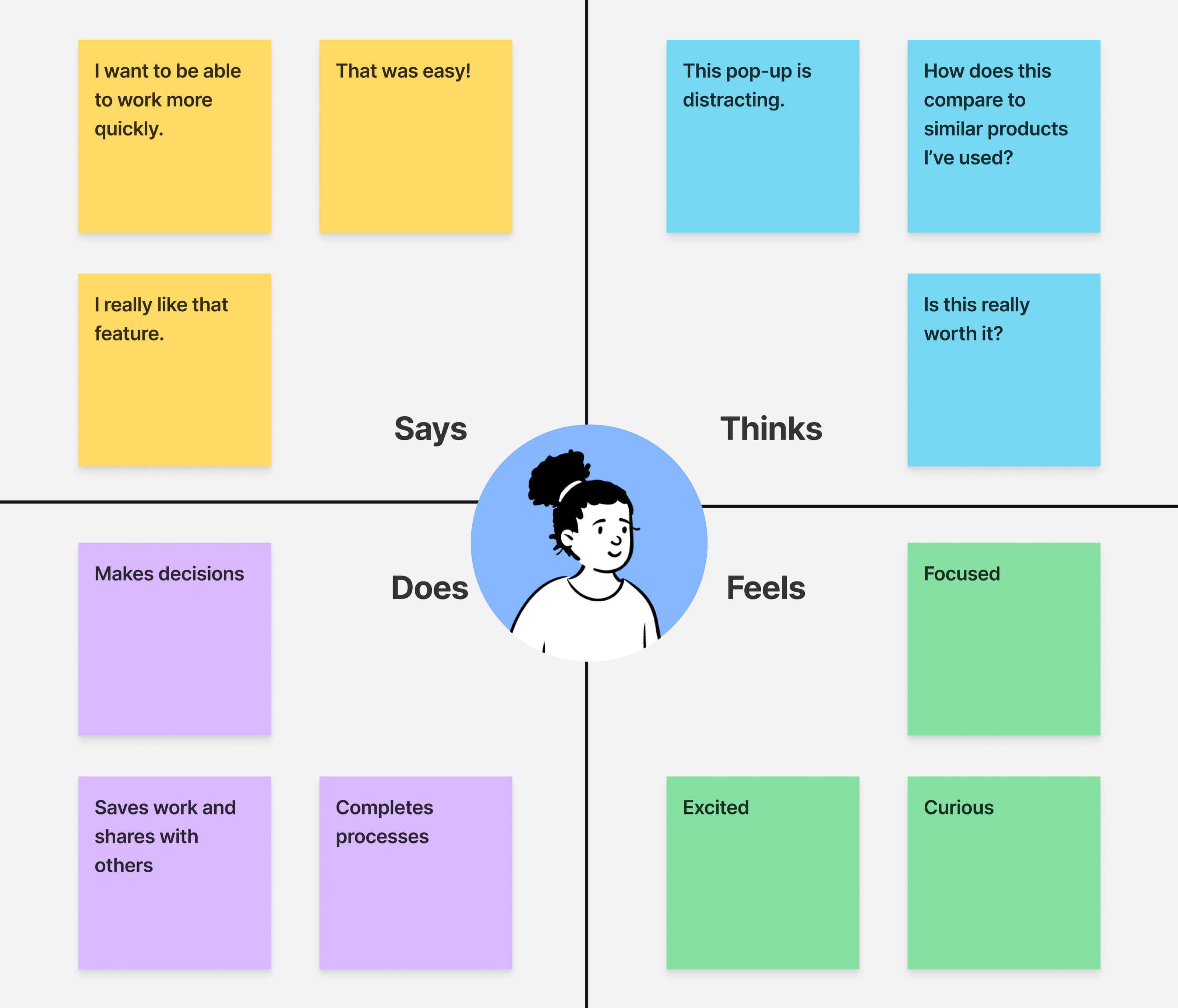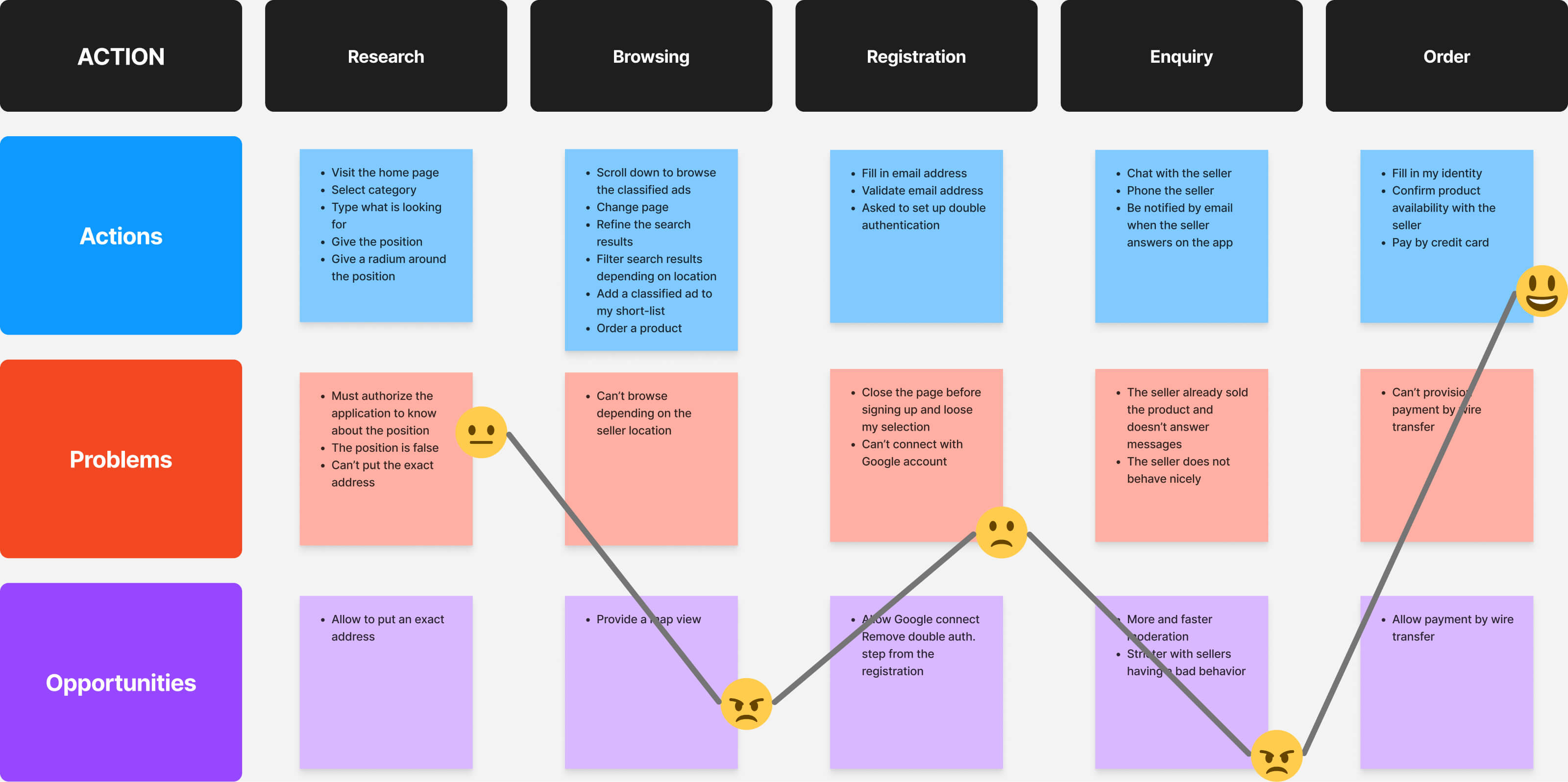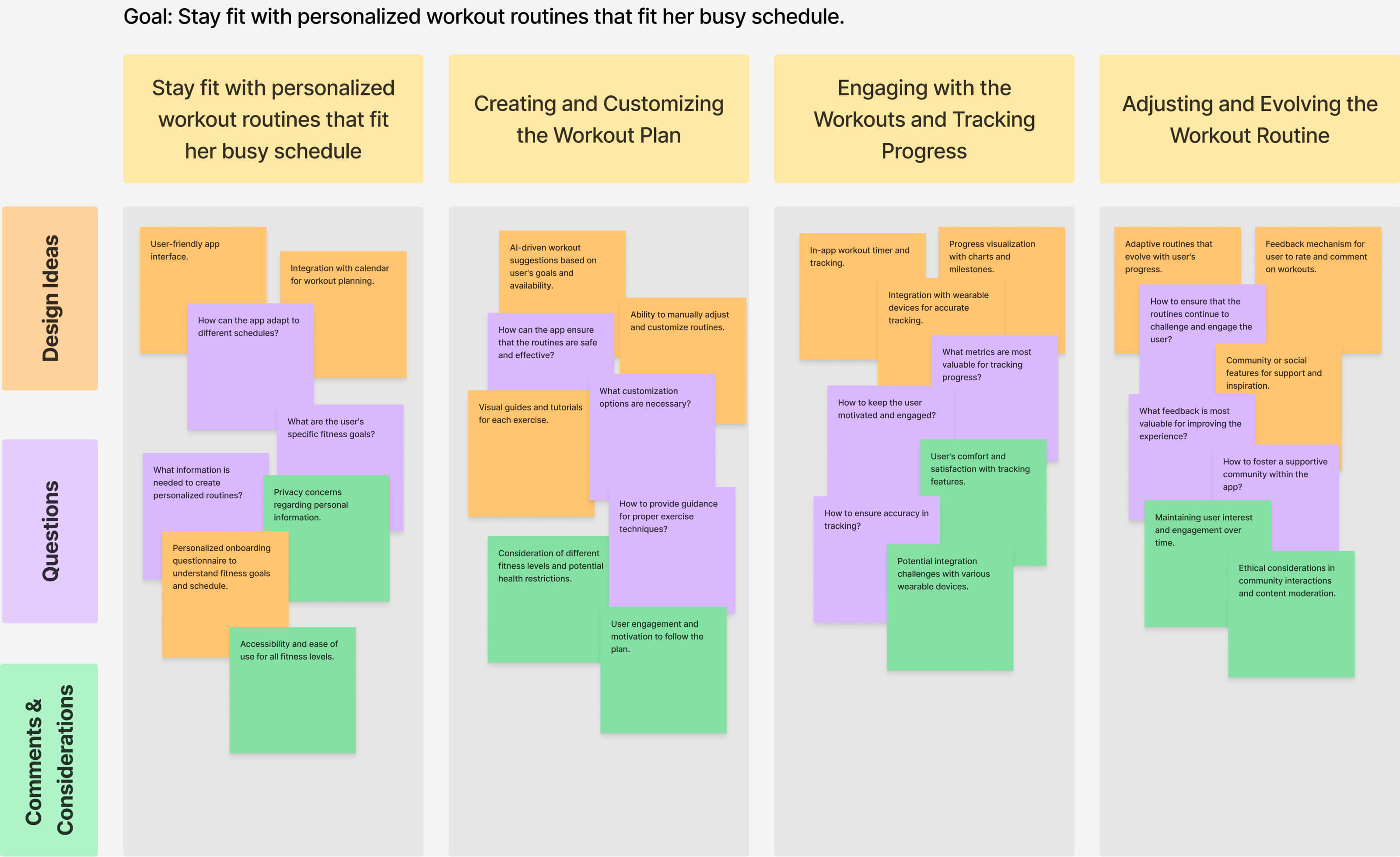What Is UX Mapping?
UX mapping is a visual representation of user experience that helps designers understand how users interact with a product or service. Its purpose is to identify user pain points, areas of opportunity, and potential improvements. By using mapping tools and techniques, designers can gain insights into user behavior and preferences.
A user experience map includes user journey maps, experience maps, empathy maps, and service blueprints. They help designers create user-centered designs that meet the needs of their target audience, resulting in a better overall user experience.
The benefits of UX mapping include improved user engagement, increased customer satisfaction, and a higher likelihood of achieving business goals in multiple departments.

Why Is UX Mapping Important?
UX mapping is an essential practice for businesses looking to improve the customer's journey. By mapping out the customer journey, businesses can bridge the gap between their digital strategy and customer experience. This knowledge enables businesses to make changes to their communication strategy, resulting in minimizing negative customer experiences.
By providing a better user experience, businesses can differentiate themselves from their competitors and build a positive reputation for themselves in the marketplace. This can help build a better brand reputation and increase conversion rates. After all, satisfied customers are more likely to make repeat purchases.
Types of UX Mapping
UX mapping tools can be used on their own, but are often used in combination with a journey map to provide a more holistic view of the user experience.
Customer Journey Mapping
Customer Journey Mapping is a visualization technique used to understand and address customer needs and challenges throughout their interaction with a specific product or service. By mapping out the customer journey, companies can identify areas for improvement and optimize the experience for their customers, ultimately leading to increased satisfaction and loyalty.
A customer journey map typically consists of several phases, each representing a stage in how the user interacts with the product or service. Within each phase, there are actions the customer takes, thoughts they have, and emotions they experience. The map should be tied to a specific product or service and should reflect the user's perspective, showing how they perceive their journey.

Empathy Mapping
Empathy mapping is an important tool for UX designers because it helps them build empathy and understanding for their target audience. By understanding their users' needs and motivations, designers can create products and services that better meet their users' needs.

An empathy map typically consists of four quadrants:
- Says represents the things the user says out loud, such as their frustrations and needs.
- Thinks represents the user's thoughts, including their goals and aspirations.
- Does represents the user's actions and behaviors, including their interactions with a product or service.
- Feels represents the user's emotions and feelings, such as their fears and desires.
Experience Mapping
Experience mapping is a tool used to illustrate the various touchpoints that a user might interact with when using a product or service. Experience maps are typically created by a team of designers, researchers, and stakeholders who collaborate to capture the user's journey and provide insight into what the user is thinking, feeling, and doing at each stage of the journey.
The UX map depicts events in chronological order, allowing designers to see the user's complete journey from start to finish. Experience maps can be used to identify areas of friction, facilitate desired outcomes, and help stakeholders understand the user's perspective.

Service Blueprinting
Service blueprinting is a design tool used to visually map out the process of delivering a service.
Service blueprint captures the user experience along with business processes, including front-stage interactions and back-stage operations. This helps identify weaknesses in service delivery, optimize opportunities for improvement, and bridge cross-departmental efforts by giving them a shared understanding of the UX journey map.

Scenario Mapping
Scenario mapping is a technique used in UX design to visualize and understand the user's journey through a product or service. It is an important tool in the design process as it helps designers identify and address design issues at the early stages of development.
Scenario mapping focuses on specific user scenarios or interactions with the product or service. These scenarios can be broken down into key elements, including the user's goals, actions, context, and emotions.

Conducting a scenario mapping workshop early in a project allows designers to gain a holistic view of the specific customer journey.
Where to Start With UX Mapping
When starting with user experience maps it's important to understand the user types and dive deeper into the user's interaction with the product. A holistic approach to user knowledge greatly supports the ux design process and elevates its outcome.
Understand the Customer Journey
Understanding the Customer Journey is a crucial aspect of user experience (UX) design. It involves mapping out the different stages that a user goes through when interacting with a product or service, from initial awareness to post-purchase evaluation.
There are several benefits to deconstructing the user's experience into smaller steps. For one, it makes it easier to identify pain points and areas for improvement. By breaking down the user's experience into smaller steps, designers can pinpoint specific areas where users are experiencing frustration or confusion, and make changes accordingly. Additionally, by identifying touchpoints that create delight, designers can create a more engaging and memorable experience for the user.
Identify Potential Customer Touchpoints
Potential customer touchpoints refer to the various points where customers interact with an organization. Each touchpoint contributes to the overall user experience and plays a crucial role in the customer journey. A poorly designed touchpoint can lead to frustration and even deter customers from returning to the organization. On the other hand, a well-designed touchpoint can create a positive impression and build customer loyalty.
For example, a potential customer touchpoint for a retail store could be the store's website, where customers can browse products and make purchases. Another touchpoint could be the physical store itself, where customers can interact with sales associates and physically examine products.

Create a User Persona
Creating user personas is a crucial step in understanding the target audience for a product or service. By developing an in depth understanding of the motivations, needs, and pain points of users, teams can design products that truly meet user needs.
To create a user persona, teams start by filling in knowledge gaps and usually conduct user research and interviews. This data is then analyzed to identify patterns and commonalities among users.
Once these patterns have been identified, a thorough description of the persona can be created. The description of the persona should include background information such as demographics, education, and employment status. It should also include their needs, concerns, and goals.
Develop User Journeys
A thorough user journey map should include key elements such as user goals, thoughts, actions, and emotions. User goals refer to the objectives or desired outcomes that users hope to achieve through a particular product or service. Thoughts refer to the way users think and feel about the product or service at any given point in their journey. Actions refer to the steps that users take to achieve their goals, while emotions refer to the feelings that users experience throughout their journey.
Identify Pain Points
Identifying pain points involves going through each phase of the customer journey and flagging any areas that need improvement. The process requires collaboration with the design team to gather different perspectives and insights.
To begin, it's important to incorporate relevant data from previous steps, such as user research and analytics. This can help to identify patterns and trends that may indicate potential pain points.

Resolve Pain Points
Resolving pain points is an important step in ensuring a positive user experience. By identifying and addressing potential issues, designers and researchers can ensure that users have a seamless experience with their product or service. Developing and testing solutions are key steps after identifying the user's issues.
How to Create a UX Map
Any mapping effort must include a comprehensive understanding of the process and its importance. From selecting the right UX mapping technique to finding a way to succesfully communicate insights into the development stage, creating a UX map should support processes in the design team.
Select the Appropriate UX Mapping Techniques
There are different user experience mapping methods that a designer can use to create better products and services, such as customer journey maps, empathy maps, service blueprints, and experience maps. When the journey mapping starts, the designer should select the appropriate UX mapping technique based on the specific needs of the project.
For instance, customer journey maps are useful when the designer wants to understand the user's journey and the different interactions with the product or service. Empathy maps, on the other hand, can help the designer understand the user's emotions, thoughts, and behaviors. Service blueprints can help the designer visualize the different touchpoints and people involved in delivering the service, while experience maps can provide a holistic view of the user's experience.
Visualize the User's Journey and Experience
Visualizing the user's journey and experience can be done by creating an experience map that tracks the entire end-to-end experience of a customer. This map should include touchpoints, needs, actions, and perceptions to gain a deeper understanding of the user's experiences and adapt the design process accordingly.
It's also important to consider the relationship between the business and the customer journey, as this can help to identify areas where improvements can be made. Strategic opportunities should be identified and incorporated into the map, as well as design innovative solutions to address customer needs and improve the overall experience. By creating a comprehensive experience map, designers can gain a deeper understanding of the user's journey and create more effective solutions to meet their needs.
Test and Iterate
Testing and iteration are crucial components of the UX mapping process. Usability testing, accessibility evaluation, and benchmark testing are all important methods for ensuring that the user experience is optimal.
Design thinking tools can be used for remote usability testing. For example, designers can use virtual whiteboards to simulate product interactions and observe how users navigate through the product. This approach can be especially valuable for remote teams.
Competitor analysis and testing also play a critical role in shaping feature planning. By analyzing the strengths and weaknesses of competing products, designers can identify opportunities for improvement.
.avif)
Gather Feedback from Stakeholders
Gathering feedback from stakeholders is an essential step in the process of UX mapping. The feedback can come from various stakeholders such as designers, developers, marketers, and end-users. Each group of stakeholders brings a unique perspective to the table, and it is essential to consider their input to create a holistic user experience.
The input from stakeholders can provide valuable insights into the user's expectations, preferences, and challenges that help in creating a user-centered design.

Do User Testing and Incorporate Feedback into the Design
When designing a product, it's crucial to incorporate feedback from real users. User testing is a powerful tool for gaining insights into how users interact with a product and identifying areas for improvement. By observing users as they interact with a product, designers can gain valuable insights into user behavior and preferences.
The most common techniques for user testing are:
- Usability testing - part of QA testing observing users as they complete tasks with a product and asking them to provide feedback on their experience;
- Focus groups - works by bringing together a group of users to discuss their experiences with a product;
- Surveys - used for gathering feedback from a larger group of users.
Incorporating feedback from user testing into the design process can lead to significant improvements in the user experience. It's important to keep in mind that user testing is an iterative process. Designers should be prepared to make changes to the product based on feedback from users and to continue testing and refining the design until it meets the needs of the user.

UX Mapping Best Practices
A user experience map is an essential tool for designers to understand and improve the user experience. When selecting a method to create a user experience map, designers must consider the design, target audience, and product goals.
Card sorting is effective for organizing content and information architecture, while journey mapping and empathy mapping are useful for understanding user needs and issues throughout the user journey.
Incorporating essential UX design principles is crucial when choosing a UX mapping method. Designers need to ensure that the method they choose aligns with these principles to guarantee the usefulness of the final map.





